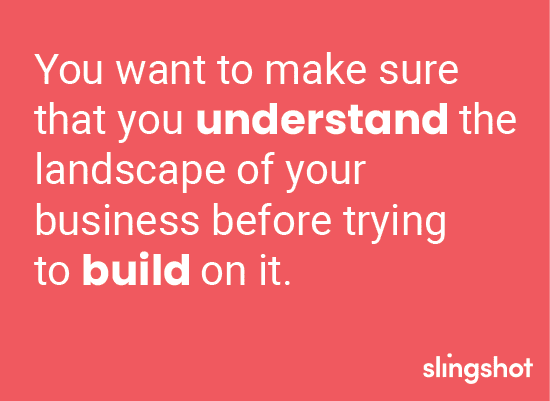Being spontaneous can be a lot of fun! Most of life’s best memories are made without much thought beforehand. Although most of the time those memories are nostalgic to look back on, they’re stressful or dangerous in the moment.
The same cannot be said for business decisions; if you decide on a whim to make big changes in your company, you’re more likely to feel the burn for a while. When it comes to tech, do you want to guess what’s coming next, or be prepared?
Being spontaneous can be a lot of fun! Most of life’s best memories are made without much thought beforehand. Although most of the time those memories are nostalgic to look back on, they’re stressful or dangerous in the moment.
The same cannot be said for business decisions; if you decide on a whim to make big changes in your company, you’re more likely to feel the burn for a while. When it comes to tech, do you want to guess what’s coming next, or be prepared?
A technology roadmap can set your business up for success, but what is it exactly? And how do you build one that’s not just good, but great? Stick around, we’d be happy to tell you!
Summary
A technology roadmap is a way to outline the tech you’ll implement. Creating a successful roadmap has 3 steps: research, create, and gather feedback.
Make sure you’re thinking about your objectives, measurements, and schedule, as well as the challenges and difficulties you’ll have to overcome.
If your roadmap is easy to grasp, adaptable to change, and honest, you’ll be good to go!
What is a Technology Roadmap?
A Technology Roadmap is a set of internal documents and diagrams that explain the what you’re building and why. This will help you implement a long-term IT strategy.

It’s important to have a tech roadmap (especially if there’s quite a bit on the horizon). The goal of this document is to help you turn IT into a strategic asset.
Having one allows everyone in the company to understand what’s happening in the tech space. You’ll have a guideline to follow when finalizing the who, what, when, where, and why of IT. That info can save you from technical debt, miscommunication, and expensive mistakes, if done correctly.
So How do you Build One?
Great question, reader! It’s not as simple as ABC; a lot of time and effort is ahead of you. But creating a technology roadmap has 3 high-level steps.
Step One – Research
When creating something that can change the course of your business, you’ll want to put in some upfront research. Since you’ll want everyone on the same page, gather a team that has representation from each corner of the business.
Before you ever pick up a pen to write out a roadmap, you’ll need to define the goals of the business. Where do you want to be by next quarter? By next decade? Think foe a while on these, as your goals will be your north star when deciding what to build.
You’ll also need to set some hard rules and boundaries. Are there any fires that need to be put out right away? Those will take precedence. You want to make sure that you understand the landscape of your business before trying to build on it.

Step Two – Create
Once you have all the background you need, it’s time to start creating! As you can imagine, this is going to be the longest step (so buckle up.)
You’ve outlined the goals you want to achieve with tech, but hope will you achieve them? By creating a technology roadmap, baby! As we mentioned above, the roadmap should provide guidance for later when you decide on the who, what, when, where, why, and how of tech in your organization.
- What products are you able to map out now?
- What are your key milestones?
- How will you measure success?
- Who is in charge of each milestone?
After you’ve played a game of 20 questions, it’s time to write some stuff down. While you may not need all of them, here are some essential parts to most roadmaps:
Goals
It’s in almost every paragraph of this article at this point: you need to start with defining your goals. We recommend putting these front and center within your technology roadmap, so you never lose sight of what you’re trying to accomplish.
The Why
It’s easy to write down goals and move on, but you should also keep track of why these goals are important. Are you wanting to improve efficiency to reduce turnaround time, or to grow? That may change over time, so you should have a plan on which goals to prioritize.
Personnel
Rome wasn’t built in a day, but more importantly it wasn’t built without people! You’re going to need a team of experts to accomplish your tech plans. Do you already have the personnel in house? Will you need to outsource development and/or support, which could affect the budget? Will you need to hire more internal staff? Having a plan is great, but if you don’t have the people or resources to complete it, your plan won’t survive off the page.
Timeline
A crucial part to a successful plan is having a general idea of when you expect milestones to be completed. At this stage you probably won’t know exact numbers, and that’s okay! Estimates are a great place to start, and a little research can help you figure out how long things will take.
A phased approach is also a good way to map out a timeline. Your immediate needs should go in a phase 1, with that phase having an estimated completion time. It’s important to not plan too far ahead; if you know tech, you know it’s changing everyday. Be prepared to pivot with new advancement and changes in the business.
Related Article: Time vs Cost in Development
Metrics
How do you know you’ve accomplished something? By having a milestone in mind when you start. If you predetermine what metrics you’ll be tracking and targeting for, it will be easier to prove whether a tech initiative was successful or not.
Risk
Mayday! It’s time for plan B! If there are potential roadblocks that may affect the outcome of the roadmap, jot them down. What are the risks involved with doing this project instead of another? You should also think beyond tech risks: what about business risks? The market risks? Risk of a meteor!? By thinking ahead on all fronts, you can better plan for anything.
Side-note: Try and set proper expectations by offering a recommendation vs risk when sharing your roadmap with stakeholders. Decide then: is this project still worth it?
Step Three – Feedback
First, take a breather. Step two was a lot of work! But once you’re well rested, it’s time to look back at your roadmap and critique it. Share it with the rest of the business and get their input and perspective. Adjust accordingly. Through collaboration, you may find you have to change the roadmap a bit.
Step three should be rinse and-repeat, meaning that you should come back and check on it every now and then. With the exponential advancement we see in tech each year, you’ll want to make sure your roadmap still fits with your goals and plans. Review periodically to make sure the roadmap is working for you, not you working to fit the roadmap.
Tips for a Successful Technology Roadmap
Now that you know how to build a good technology roadmap, there are some things you should keep in mind to make sure that the roadmap is great. Here are 3 tips for creation a successful roadmap:
Easy
Details are certainly important, since you want to make sure you cover all your bases. But you should also note that a lot of people are going to need to understand your roadmap on the first readthrough. Try and present as much information as you can in an easily digestible way. Visuals and outlines are great ways to start.

Your roadmap should also be easy to access. Since there are many different people that will want access to your roadmap, it should live somewhere everyone can access it. If you don’t do this, you’ll have two realities: either you’ll have to share it with everyone anytime there’s an update, or no one will bother with it.
Flexible
Remember step 3? When you come back to your roadmap, change may be necessary. Keeping a mindset that your roadmap isn’t set in stone from the beginning will give you more room to be creative and innovative. It’s cheesy, but your technology roadmap is a living document that needs updated.
Practical
If you want a roadmap that’s going to stand the test of time, you’re going to have to be honest with yourself. If you limit the cost or shorten a timeline below what’s actually needed, you’re going to end up with a document that is unrealistic to achieve.
You should also keep in mind that you’re never going to get every person on board with every piece of the roadmap. We mentioned it above, but there’s going to be some kind of compromise. Be honest with what the goals are, and do your best to always share the reasoning behind why something is on the roadmap in terms the business can understand.
Conclusion
Your technology roadmap should be a guideline showcasing what’s on your tech timeline and why it’s there. By setting time aside for upfront research and after review, you’ll have a roadmap that checks all your boxes.
Make sure you’re keeping in mind the goals, metrics, and timeframe you’ll want to achieve, as well as the barriers and obstacles you’ll have to tackle. If you create a roadmap that’s easy to understand, flexible to change, and practical to you, you’ll be in great shape.
Spontaneity can be great, but having a guideline to go off of can help you from getting burned. Here’s to planning!




